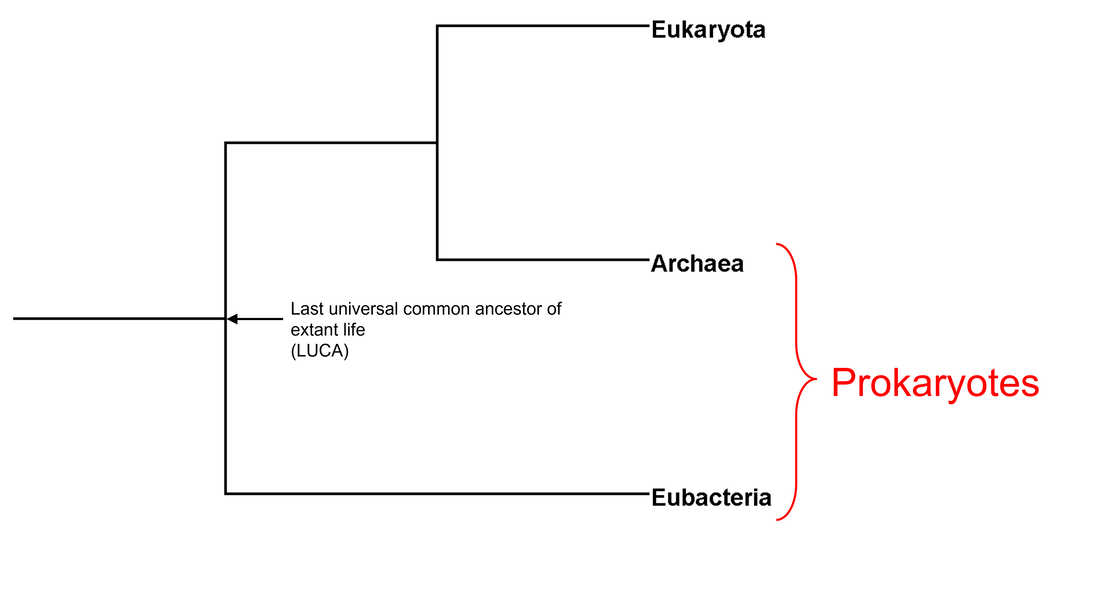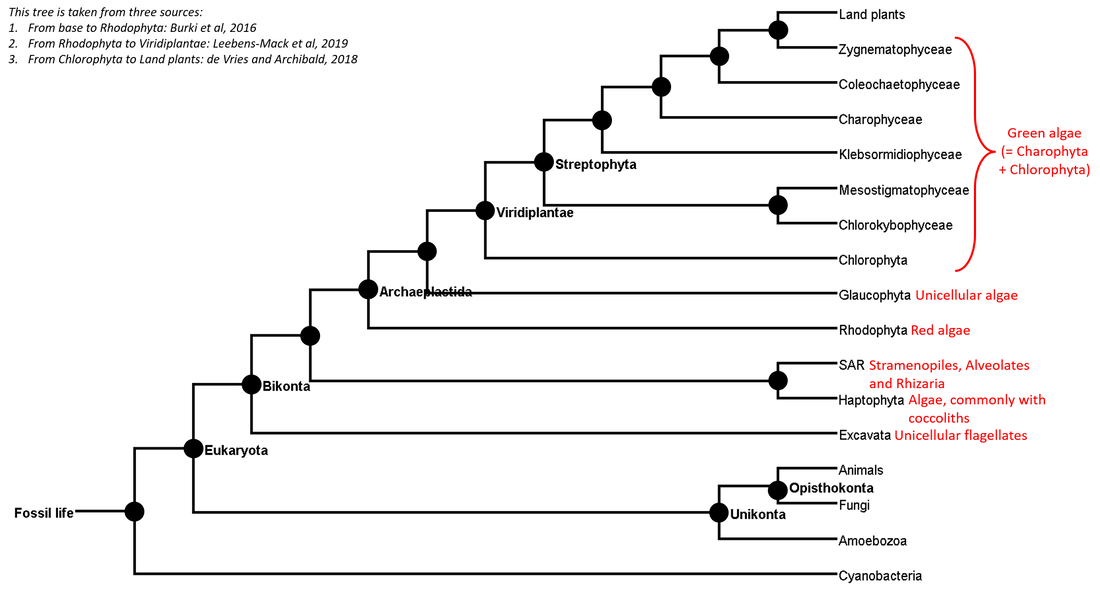The evolution of life is a vast topic, involving an immense literature representing biological and geological disciplines. Only a relatively small fraction of this field of knowledge can be covered here: the extent to which the process of evolution is documented by means of fossils. There are many life-forms that are not known as fossils, such that their evolution can only be determined using molecular (DNA) analysis rather than by paleontology. This study deals only with organisms that have been found in fossil form. However, many of the phylogenetic trees presented in this website are based at least partly on molecular data.
Before proceeding to phylogeny based on fossils, we will set the scene by considering the classification of all life, expressed in the following phylogenetic tree:
Before proceeding to phylogeny based on fossils, we will set the scene by considering the classification of all life, expressed in the following phylogenetic tree:
The three terminal groups shown above represent the three domains of life as proposed by Woese et al (1990). The Eubacteria, or true bacteria (Kingdom Bacteria according to Ruggiero et al, 2015), contain the cyanobacteria, which are known as fossils. The Archaea (Kingdom Archaea according to Ruggiero et al, 2015) physically resemble the true bacteria but are genetically distinct from the latter (Biology Online Dictionary). Both the Eubacteria and the Archaea belong to the prokaryotes (Superkingdom Prokaryota according to Ruggiero et al, 2015), which are organisms whose cells do not contain a distinct nucleus bounded by a nuclear envelope (Biology Online Dictionary). The third domain, the eukaryotes (Superkingdom Eukaryota according to Ruggiero et al, 2015) contains all the fossils considered in this website.
The following phylogenetic tree shows the classification of organisms that are known as fossils:
The following phylogenetic tree shows the classification of organisms that are known as fossils:
The black dots represent the nodes of the successive crown groups into which life has divided. All of the groups on the right-hand side of this tree have fossil representatives. However, many of them are not sufficiently well represented to provide adequate information to illustrate their evolution, so this website will deal only with the two groups that have an excellent fossil record, the animals (or Metazoa) and the land plants (or Embryophyta).
All of the groups shown on the right-hand side of the above tree, except for the cyanobacteria, belong to the Eukaryota, which comprise all organisms that have cells in which the nucleus is enclosed within a membrane (Biology Online Dictionary). The cyanobacteria, also known as “blue-green algae”, belong to the prokaryotes.
The remainder of this main section of the website is divided into four parts:
• The origin of the eukaryotes
• Evolution of the animals
• Evolution of the land plants
• Glossary of terms
All of the groups shown on the right-hand side of the above tree, except for the cyanobacteria, belong to the Eukaryota, which comprise all organisms that have cells in which the nucleus is enclosed within a membrane (Biology Online Dictionary). The cyanobacteria, also known as “blue-green algae”, belong to the prokaryotes.
The remainder of this main section of the website is divided into four parts:
• The origin of the eukaryotes
• Evolution of the animals
• Evolution of the land plants
• Glossary of terms
References
Burki, F., Kaplan, M., Tikhonenkov, D. V., Zlatogursky, V., Minh, B. Q., Radaykina, L. V., ... & Keeling, P. J. (2016). Untangling the early diversification of eukaryotes: a phylogenomic study of the evolutionary origins of Centrohelida, Haptophyta and Cryptista. Proceedings of the Royal Society B: Biological Sciences, 283(1823), 20152802.
de Vries, J., & Archibald, J. M. (2018). Plant evolution: landmarks on the path to terrestrial life. New Phytologist, 217(4), 1428-1434.
Leebens-Mack, J.H., Barker, M.S., Carpenter, E.J. et al. (2019). One thousand plant transcriptomes and the phylogenomics of green plants. Nature 574, 679–685. https://doi.org/10.1038/s41586-019-1693-2.
Woese, C. R., Kandler, O., & Wheelis, M. L. (1990). Towards a natural system of organisms: proposal for the domains Archaea, Bacteria, and Eucarya. Proceedings of the National Academy of Sciences, 87(12), 4576-4579.
de Vries, J., & Archibald, J. M. (2018). Plant evolution: landmarks on the path to terrestrial life. New Phytologist, 217(4), 1428-1434.
Leebens-Mack, J.H., Barker, M.S., Carpenter, E.J. et al. (2019). One thousand plant transcriptomes and the phylogenomics of green plants. Nature 574, 679–685. https://doi.org/10.1038/s41586-019-1693-2.
Woese, C. R., Kandler, O., & Wheelis, M. L. (1990). Towards a natural system of organisms: proposal for the domains Archaea, Bacteria, and Eucarya. Proceedings of the National Academy of Sciences, 87(12), 4576-4579.
Photo credit
Header: Stromatolite, Quebec, Canada. By André-P. Drapeau P. [CC BY-SA 3.0 (https://creativecommons.org/licenses/by-sa/3.0)], from Wikimedia Commons
Header: Stromatolite, Quebec, Canada. By André-P. Drapeau P. [CC BY-SA 3.0 (https://creativecommons.org/licenses/by-sa/3.0)], from Wikimedia Commons

